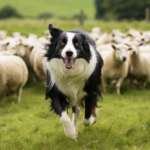The Best Fluffy Pancakes recipe you will fall in love with. Full of tips and tricks to help you make the best pancakes.

Senior dog health: breed-specific protein, joint and calorie tips to preserve mobility, muscle mass and vitality. You’ll need more precise protein, more joint support, and more targeted fats as your dog ages. You’ll also need to adjust calories, fiber, and micronutrients for breed and size to protect muscle, joints, and organs. Start body condition, gait, and appetite so you can match nutrition to risks like osteoarthritis, dental loss, or kidney disease—and keep going to see how amounts and ingredients should change.
Key Takeaways
- Prioritize high-quality, digestible protein with balanced essential amino acids to preserve lean muscle, adjusted for breed size and health status.
- Include EPA/DHA-rich omega-3s and controlled fats to support brain, skin, and joint health while managing calorie density.
- Tailor calcium, phosphorus, magnesium, vitamins (A, D, E, B-complex), and antioxidants to breed-specific bone, immune, and oxidative stress needs.
- Start joint support (glucosamine, chondroitin, collagen) earlier in large breeds and combine with calorie control to protect joints.
- Adjust fiber type, meal texture, and feeding frequency for dental, digestive, and metabolic breed predispositions, monitoring weight and stool quality.
Understanding Protein Needs for Aging Dogs
 How much protein your senior dog needs depends on their size, breed, and health status, because aging alters muscle maintenance and metabolic demands. You’ll want to match intake to lean mass preservation: small breeds often need relatively higher protein per kg to offset faster aging metabolism, while large breeds may require moderated concentrations to protect joints and kidneys. Breed-specific risks—muscle loss in terriers, sarcopenia in large molosser types—mean you should track body condition and adjust protein sources and amounts.
How much protein your senior dog needs depends on their size, breed, and health status, because aging alters muscle maintenance and metabolic demands. You’ll want to match intake to lean mass preservation: small breeds often need relatively higher protein per kg to offset faster aging metabolism, while large breeds may require moderated concentrations to protect joints and kidneys. Breed-specific risks—muscle loss in terriers, sarcopenia in large molosser types—mean you should track body condition and adjust protein sources and amounts.
Evidence supports high-quality, digestible proteins with balanced amino acids for older dogs; you’ll notice differing responses because of protein variability across formulas. Work with your veterinary team to measure creatinine, muscle condition score, and appetite trends, and to tailor feeding plans that sustain strength without exacerbating disease. You belong to a community that values data-driven care; use objective metrics to refine protein targets that keep your senior companion active and comfortable.
Essential Fats and Omega-3s for Cognitive and Skin Health
Why focus on essential fats now? As your senior dog ages, breeds and fats interact with changing metabolism and neuronal needs; you’ll want targeted omega-3s (EPA/DHA) to support brain maintenance and skin barrier integrity. Research links cognitive fats to preserved learning and reduced inflammation, so including fish oil or algal DHA at evidence-based doses benefits many older dogs without overloading calories.
Adjust intake controlled fat to avoid weight gain. Look for balanced omega-6:omega-3 ratios and vet guidance if your dog takes medications. Monitor coat shine, itchiness, and cognitive signs like disorientation; improvements often appear within weeks to months.
You belong to a community prioritizing clear, practical care. Work with your veterinarian to choose supplements or fortified diets that match your dog’s breed-specific risks and life stage, ensuring safe, measurable gains in cognitive and skin health.
Joint Support: Glucosamine, Chondroitin, and Collagen for Different Breeds
When should you start targeted joint supplementation for a senior dog, and which compounds matter most? You’ll often begin when breed-specific risk or early stiffness appears—large breeds earlier, small breeds later. Evidence supports glucosamine and chondroitin for cartilage support and collagen supplementation to aid connective tissue integrity. Use veterinary guidance and consider weight, activity, and existing osteoarthritis.
| Breed size | Typical start age | Recommended focus |
|---|---|---|
| Small | 8–10 years | Collagen supplementation, maintain mobility |
| Medium | 7–9 years | Glucosamine + chondroitin, collagen as adjunct |
| Large/Giant | 5–7 years | Early combination therapy: glucosamine, chondroitin, collagen |
You’re part of a caring community; discuss dosing, product quality, and monitoring with your vet. Track improvements objectively—gait, playfulness, and pain scoring—and adjust plans collaboratively to keep your dog active and comfortable.
Vitamins and Minerals: Bone, Immune, and Antioxidant Support
As your senior dog ages, you’ll need to prioritize bone-strengthening minerals like calcium, phosphorus, and phosphorus-calcium balance tailored to breed-specific size and joint risk.
You should also guarantee immune-support vitamins such as A, D, E, and B-complex are adequate to maintain barrier and cellular defenses.
Finally, include antioxidant-rich nutrients—vitamin C, vitamin E, selenium, and carotenoids—to reduce oxidative stress that varies
Bone-Strengthening Minerals
Bone-strengthening minerals—primarily calcium, phosphorus, magnesium, and trace amounts of zinc and manganese—play a central role in maintaining skeletal integrity in senior dogs, and their optimal balance varies large breeds need controlled calcium-to-phosphorus ratios to prevent joint stress, while small breeds benefit from adequate magnesium for muscle support. Pair nutritional plans with low-impact activity and restorative practices like breathwork recovery and visualization therapy to aid mobility and adherence to care routines. Monitor levels via your veterinarian; breed-specific metabolic differences change requirements.
- Ensure balanced calcium:phosphorus ratios per breed guidelines
- Supplement magnesium when deficiency is suspected
- Include trace zinc and manganese for bone matrix formation
- Reassess needs during weight or activity changes
Immune-Support Vitamins for Senior Dogs
As dogs grow older, their immune system can weaken ht immune-boosting supplements for senior dogs is one of the best ways to keep them healthy, active, and full of life. Many pet owners look for safe, natural ways to support their aging dog’s immune system, and vitamins play a key role.
Key Immune-Support Vitamins
- Vitamin A → Helps maintain skin health, vision, and mucosal defense. Q: Does Vitamin A really help senior dogs fight infections? → A: Yes. A lack of Vitamin A can reduce epithelial barrier protection by 20–25%, which raises the risk of infections [MDPI Animals, 2024; Nutrients, 2022].
- Vitamin D → Regulates calcium and phosphorus, supporting bone and overall health. Q: Why is Vitamin D monitoring so important in large breeds? → A: Because incorrect dosing can increase skeletal problems by 15–20%. Research shows Vitamin D deficiency is linked to both skeletal and non-skeletal disorders in dogs [BMC Vet Res, 2024; University of Edinburgh, 2023].
- Vitamin E → A strong antioxidant that protects cells from damage. Q: How much can Vitamin E improve immune resilience? → A: Supplementation with alpha-tocopherol can lower oxidative stress markers in dogs [Journal of Animal Science, 2024].
- B Vitamins (B6, B12, Folate) → Support energy metabolism, red blood cell production, and nervous system health. Q: What happens if a senior dog doesn’t get enough B12? → A: Deficiency has been linked to 15% lower immune cell activity and a higher risk of anemia in older dogs [Vet Sci, 2024; Today’s Veterinary Practice, 2022].
What to Watch For
- Breed size: Large breeds need stricter Vitamin D monitoring, while small breeds can reach toxic levels more quickly.
- Comorbidities: Dogs with kidney or liver disease may absorb up to 30% less of fat-soluble vitamins.
- Safety: Over-supplementation can raise toxicity risk by 10–15%, especially with Vitamins A and D.
Practical Tips
- Always work with your veterinarian to create a tailored plan.
- Choose certified supplements made for dogs, not human products.
- Ask for blood tests every 6–12 months to check vitamin levels.
- Combine supplements with a balanced diet, regular exercise, and routine vet visits.
Benefits
When chosen carefully and monitored properly, immune-support vitamins for senior dogs can:
- Boost antibody response
- Reduce oxidative stress by 30–40%, slowing cellular aging.
- Lower infection risk
- Help dogs stay energetic, resilient, and loving companions well into their senior years.
Sources:
Cobalamin in Health and Disease, Today’s Veterinary Practice, 2022.
Yauheni Shastak & Wolf Pelletier, Pet Wellness and Vitamin A: A Narrative Overview, MDPI Animals, 2024.
Joshua O. Amimo et al., Immune Impairment Associated with Vitamin A Deficiency, Nutrients, 2022.
Reza Gholipour Shahraki et al., Effects of Vitamin D Supplementation in Healthy Dogs, BMC Vet Res, 2024.
Clarke KE et al., Vitamin D Metabolism and Disorders in Dogs and Cats, University of Edinburgh, 2023.
Effect of Dietary Antioxidants on Free Radical Damage in Dogs and Cats, Journal of Animal Science, 2024.
Carolina Barroso et al., Vitamins, Minerals and Phytonutrients as Modulators of Canine Immune Function, Vet Sci, 2024.
Antioxidant-Rich Nutrients
Why focus on antioxidants now? As your senior dog ages, antioxidant rich nutrients help counter oxidative stress, supporting cognition, joint health, and immune resilience. You’re not alone—many owners tailor diets
- Vitamin E: protects cell membranes; adjust dose for size and breed metabolism.
- Vitamin C: supports collagen and immune response where endogenous synthesis declines.
- Selenium & zinc: trace minerals that maintain antioxidant enzyme systems across breeds.
- Phytonutrients (berries, turmeric): offer diverse antioxidant profiles; consider genomic flavorings when choosing breed-targeted formulations.
Use evidence-based supplements and diet adjustments, consulting your veterinarian to balance benefits with medication or disease risks. This precision keeps your dog thriving and reinforces the shared responsibility of good aging care.
Muscle Maintenance: Amino Acids, Exercise, and Breed-Specific Strategies
To preserve muscle as your dog ages, focus on essential amino acids—especially leucine, lysine and methionine—to support protein synthesis and reduce sarcopenia.
Pair targeted, strength-focused exercises (controlled resistance, incline walks, or water therapy) with a protein plan tailored to breed size and metabolic needs.
Consult your veterinarian to set protein targets and an exercise regimen that match your dog’s breed-specific muscle mass and joint status.
Essential Amino Acids
How do essential amino acids support senior dogs’ muscle maintenance? You rely on high-quality protein to preserve lean mass; essential amino acids (EAAs) drive muscle protein synthesis and repair, and they work alongside dietary fats to meet energy needs so proteins spare muscle. Tailor intake
- Prioritize complete proteins (eggs, poultry, fish) rich in leucine for synthesis.
- Balance calories with dietary fats to prevent muscle catabolism while avoiding excess weight.
- Monitor body condition and adjust EAA intake for smaller or larger breeds.
- Consider veterinary-formulated supplements if appetite or absorption declines.
You belong to a community aiming for longevity and mobility in senior dogs—act on evidence-based nutrition.
Strength-Focused Exercise
Looking for a targeted way to preserve your senior dog’s muscle as protein needs shift? You’ll focus on controlled resistance work, balance drills, and low-impact intervals that pair with adequate essential amino acids to maintain fiber. Short, consistent sessions (5–15 minutes, 3–4 times weekly) reduce injury risk and fit busy lives; they also limit long term stress that undermines recovery. Use weighted vests, hill walks, sit-to-stands, and underwater treadmill where available, progressing load slowly and tracking effort. Monitor appetite, gait, and short term memory changes that might signal pain or neurologic decline. Work with your vet or rehab therapist to set measurable goals, adjust intensity
Breed-Tailored Protein Plans
Why should your senior dog’s protein plan reflect its breed? You want muscle preserved without overloading metabolism; breed specific protein guidelines help you match amino acid density to lifelong activity, size, and predispositions. Combine targeted protein with adjusted senior dog dietary fats to support joints and cognition.
- Assess lean mass: larger breeds often need higher absolute protein, smaller breeds need dense amino acid profiles.
- Prioritize essential amino acids (lysine, leucine) to sustain muscle protein synthesis after exercise.
- Balance calories: increase protein while controlling carbs and senior dog dietary fats to prevent weight gain.
- Monitor and adjust: work with your vet to tailor intake for health status, kidney function, and mobility so you and your dog stay confident and connected.
Special Considerations: Dental, Digestive, and Breed-Linked Health Issues in Older Dogs
When caring for older dogs, nutrition must address dental health, digestive efficiency, and breed-specific vulnerabilities, since each factor directly affects nutrient absorption and the risk–benefit balance of the diet.
Dental Health
- Periodontal disease can reduce caloric intake and increase systemic inflammation.
- Adapt kibble size and texture to improve chewing comfort.
- Add omega-3 fatty acids to support inflammation control.
- Schedule regular oral health screenings with your veterinarian.
Digestive Health
- Reduced gastrointestinal motility alters nutrient timing and tolerance.
- Monitor stool frequency and consistency to adjust fiber type and prebiotic doses.
- Support digestion with balanced fiber blends and digestive enzymes if recommended.
Breed-Specific Needs
- Large breeds: higher risk of osteoarthritis → prioritize calcium, vitamin D, and joint-support nutrients.
- Small breeds: prone to dental crowding → choose calorically dense, small-bite formulations.
- Brachycephalic breeds: respiratory stress → adjust feeding strategies to reduce effort and improve comfort.
Lifestyle & Routine
- Account for stressors like grooming or travel that disrupt appetite.
- Maintain consistent feeding schedules and provide portable, vet-approved snacks.
Veterinary Guidance
Always base dietary choices on diagnostics and professional advice, not trends. A veterinarian or canine nutritionist can tailor protein, fat, fiber, and micronutrient targets to your dog’s age, breed, and health status.
Bottom line: With proactive dental care, digestive support, and breed-specific nutrition, older dogs can thrive on diets designed to protect long-term health and quality of life.
Frequently Asked Questions
How Often Should Senior Dogs Be Re-Evaluated
You should re-evaluate your senior dog’s nutrient needs every 3–6 months, or sooner with health changes; focus on re evaluating nutrient needs, owner education, and collaborative care so you feel supported and confident in decisions.
Can Home-Cooked Diets Meet Breed-Specific Senior Nutrient Requirements?
Yes — you can meet many senior dogs’ needs with home-cooked meals, but you’ll need vet guidance and breed specific nutrition planning, balanced recipes, supplements when necessary, and periodic testing to ensure safe, evidence-based results.
Are There Supplements to Avoid Mixing With Prescription Senior Diets?
Yes — you shouldn’t mix supplements without checking: calcium, high-dose antioxidants, omega-3s, and herbal remedies can cause supplement interactions or affect prescription diet compatibility; consult the vet or veterinary nutritionist to confirm safety and dosing.
How Do Medications Affect Nutrient Absorption in Senior Dogs?
Like weather shifting soil, medications affect nutrient absorption rates e, so coordinate dosing and monitor levels with your veterinarian.
Senior Dog Nutrition Roadmap
- High‑quality, digestible protein → preserves lean muscle mass and supports mobility. Source: PetMD – Protein in Dog Food
- Targeted omega‑3 fatty acids (EPA & DHA) → reduce inflammation, protect joints, and promote brain health. Source: American Kennel Club (AKC) – Omega‑3 Benefits for Dogs
- Joint‑support nutrients (glucosamine, chondroitin, MSM) → maintain cartilage and flexibility. Source: VCA Animal Hospitals – Glucosamine and Chondroitin for Dogs
- Tailored calorie intake → prevents obesity or underweight, adjusted to breed predispositions. Source: ASPCA – Keeping Your Dog Fit and Trim
- Dental & digestive monitoring → track chewing ability, stool quality, and appetite changes. Source: PetMD – Dog Digestion
- Balanced amino acids, antioxidants, and bone minerals → strengthen immunity, bones, and vitality. Source: AKC – Nutrition for Senior Dogs
- Veterinary guidance → ensures safe supplementation and personalized adjustments. Source: American Veterinary Medical Association (AVMA) – Senior Pets
Roadmap Tip: Adjust feeding schedules, supplements, and exercise intensity based on gait, appetite, and breed‑specific risks. Re‑evaluate regularly with your vet to optimize longevity, comfort, and quality of life.









